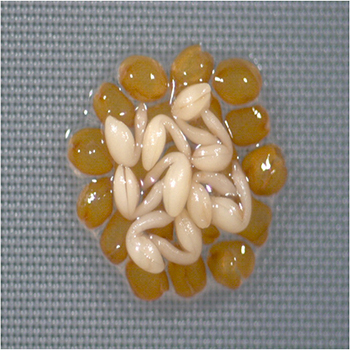Four fairies watch over Sleeping Beauty

Seed germination is a crucial step in the life cycle of a plant. This is why the small embryo is maintained in a state of dormancy until the appearance of optimal environmental conditions. The quality of its sleep is insured by the envelope of the seed, which continuously produces a hormone named ABA. A study led by the universities of Pohang (POSTECH), Zurich (UZH) and Geneva (UNIGE) reveals how the transport of the hormone to the embryo is controlled, for which no less than four transporters are involved. Published in Nature Communications, these results should also have practical applications, since this knowledge can be integrated in breeding programs to avoid producing seeds displaying premature germination and, so, cutting economic and environmental losses.
To germinate, or not to germinate: that is the most important question in the life of a plant. The tiny embryo must be sure to abandon the highly protected state of the dry seed to become a fragile seedling only under the best environmental conditions. One of the safeguards to prevent “false starts”, such as premature germination out of season, is provided by the dormancy of newly made seeds. This trait ensures that germination is blocked upon seed imbibition even under apparent favorable conditions. In addition, it increases chances of seed dispersal, thus avoiding competition among individuals of the same species.
“We discovered in 2010 that dormant seed coats continuously release abscisic acid (ABA), which blocks the growth and greening of the embryo within the seed. This phytohormone also plays important roles later during the green phase of the plant, such as regulation of leaf transpiration rates”, says Luis Lopez-Molina, professor at the Department of Botany and Plant Biology in the Faculty of Sciences of UNIGE, Switzerland.
A network of transporters
In the plant-model Arabidopsis thaliana, the state of dormancy is maintained by the endosperm, a single cell layer within the seed coat surrounding the embryo, which synthesizes and continuously releases ABA towards the embryo. “The mechanism of ABA transport from the endosperm to the embryo was hitherto unknown. We reasoned that this process must be accurately controlled and thus might be mediated by multiple coordinated groups of transporters”, explains Youngsook Lee, professor at the Division of Integrative Biology and Biotechnology of Pohang University of Science and Technology (POSTECH), Korea.
In collaboration with the UZH, Switzerland, the researchers discovered a network of ABA transporters, all members of the same family named ABC transporters. “Two of them act in concert to deliver ABA from the endosperm to the embryo, whereas two others import the hormone into the embryo. All four transporters are required to efficiently suppress seed germination”, reveals Joohyun Kang, post-doctoral fellow at the Institute of Plant Biology of the UZH.
Propel a hormone to the crown of a tree
As some of these ABA transporters are also expressed in plants throughout their life cycle, this research will pave the way for studies that examine other stress- and development-related reactions that require the coordinated short- and long-distance transport of ABA within the plant. “Our study should also have practical applications, since this knowledge can be integrated in breeding programs to avoid producing seeds displaying premature germination. For example, mutant seeds unable to synthesize ABA lack dormancy and may even germinate while still attached to the mother plant. This phenomenon, termed vivipary, results in economic loss in crop species”, concludes Enrico Martinoia, professor at the Institute of Plant Biology of the UZH.
Contact: Luis Lopez Molina +41 22 379 32 06
11 Dec 2015